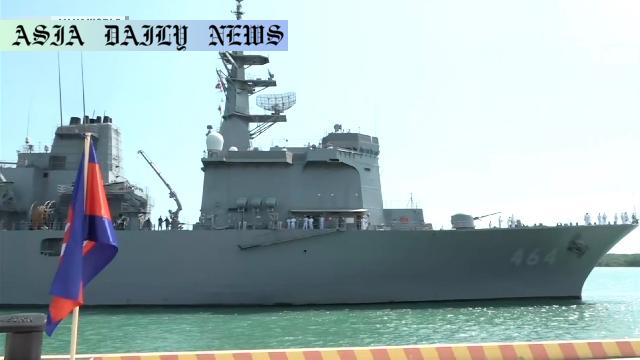Japan MSDF vessels visit Ream Naval Base, promoting cooperation with Cambodia while navigating concerns over China’s influence.
- Japan’s MSDF vessels visit Ream Naval Base post-expansion.
- Base expansion funded by China; U.S. raises concerns.
- Visit signifies Japan-Cambodia cooperation amid maritime tensions.
- Cambodia seeks balance in global diplomacy by hosting Japan.

Japan MSDF Vessels Make a Significant Move at Newly-Expanded Cambodian Base
Enhanced Cooperation Between Japan and Cambodia
Two vessels from Japan’s Maritime Self-Defense Force (MSDF), the minesweeper tender Bungo and minesweeper Etajima, marked a historic event by making a port call at Cambodia’s Ream Naval Base. This port visit comes at a time of heightened maritime activity in the region, drawing significant geopolitical attention. The visit was made possible through mutual efforts between Japan and Cambodia to deepen cooperation. Captain Amano Shinsuke, the commander of the MSDF’s Minesweeper Division 3, underscored this collaboration during a welcome ceremony, highlighting the importance of fostering partnerships in such critical times. The Cambodian Navy reciprocated this friendly gesture with a warm welcome, reflecting the strong and growing ties between the two nations.
A Symbolic Visit Amid China’s Expanding Influence
Ream Naval Base, situated in Cambodia’s southwest, has recently undergone a significant expansion and upgrade, completed with financial and material assistance from China. This expansion has raised concerns among global powers, particularly the United States, which suspects that the base might be utilized for military purposes benefiting China. Japan’s decision to send its first foreign vessels to the newly-enhanced base underscores a strategic move aimed at striking a balance in the region while emphasizing Japan’s commitment to partnership and collaboration with smaller Southeast Asian nations. The presence of the vessels symbolizes an effort to assert Japan’s intentions for peaceful and cooperative maritime activity, while also subtly pushing back against growing Chinese influence in the region.
Cambodia’s Diplomatic Balancing Act
Cambodia, on its part, has carefully walked the diplomatic tightrope. On the one hand, it has welcomed China’s contributions to modernize Ream Naval Base, a project that has undoubtedly brought economic and military benefits. On the other hand, Cambodia has demonstrated a willingness to engage with other global powers like Japan and the United States. Analysts suggest that hosting Japan’s MSDF vessels shortly after completing the Chinese-funded expansion signals Phnom Penh’s attempt to maintain a neutral and balanced position. Such gestures strengthen Cambodia’s image as a sovereign player, embracing opportunities from all interested parties while avoiding over-reliance on any single foreign influence.
Geopolitical Implications and Maritime Security
The visit by Japan’s MSDF vessels carries significant geopolitical implications. It not only strengthens Japan’s diplomatic ties with Cambodia but also indirectly addresses the broader challenges presented by China’s rising assertiveness in maritime affairs. The port call also highlights the ongoing efforts by Japan and likeminded nations to ensure freedom of navigation, open trade routes, and peaceful resolutions in areas strained by territorial disputes. This strategic maneuver underscores Japan’s commitment to preserving a rules-based international order in the Indo-Pacific region by engaging with smaller but strategically situated nations like Cambodia. By engaging in cooperative efforts, Japan sends a clear message about its respect for sovereignty and its commitment to strengthening regional partnerships.
The Road Ahead for Regional Cooperation
The interactions between the Japanese MSDF and the Cambodian military further highlight the need for collective regional security efforts. Both sides appear to agree on the importance of mutual respect and shared goals for stability across maritime borders. As Japan continues to showcase its capacity for non-threatening presence and partnership, smaller nations in Southeast Asia may grow more confident in aligning with such a strategy. Meanwhile, by managing diplomatic outreach equitably, Cambodia reinforces its agency in global diplomacy. Moving forward, cooperative gestures like these hold vast potential to bolster multilateral engagements and foster strategic capabilities for maintaining peace and order in the Indo-Pacific theater.



Commentary
Commentary: Significance of Japan MSDF Vessels’ Visit to Cambodia
Japan’s Strategic Diplomacy through Naval Collaboration
The port call of Japan’s Maritime Self-Defense Force (MSDF) vessels at Cambodia’s Ream Naval Base marks a milestone not just for bilateral ties between Japan and Cambodia, but also for the broader geopolitical dynamics in Southeast Asia. Japan’s decision to send its MSDF forces to this newly-expanded naval facility demonstrates its strategic approach to maritime diplomacy. It reveals Japan’s deliberate attempts at nurturing smaller allies in the region, offering them partnerships not solely bound by economic dependence but also strategic security assurance. In a world where China’s reach continues to grow unabated in Southeast Asia, Japan’s timely engagement adds an important counterbalance.
Cambodia’s Intricate Balancing Act
From Cambodia’s perspective, hosting vessels from Japan at a naval base rebuilt with Chinese support is not just a diplomatic nicety—it’s a statement. Phnom Penh’s balancing act is becoming increasingly evident. By accepting China’s substantial financing for the modernization of its key naval facility and then welcoming Japan’s maritime vessels with open arms, Cambodia signals to the world its nuanced foreign policy that prioritizes balance and sovereignty. Its actions exemplify the pragmatic approach of smaller nations navigating the competing interests of global superpowers. How Cambodia succeeds in maintaining this equilibrium will define its future relations with both sides.
Importance to Regional Stability
This move also sheds light on a broader issue: the future of regional stability in the Indo-Pacific. Japan’s involvement demonstrates that even middle-powers can significantly influence regional equations. By fostering trust and offering partnerships, Japan ensures that its neighbors are not solely in the ambit of China’s comprehensive outreach. It sends a message to the world that maritime cooperation rooted in mutual respect and shared values will continue to be a compelling alternative to other approaches. For Cambodia, and other nations like it, such partnerships offer diversified avenues of growth and security, free from one-sided dependencies.